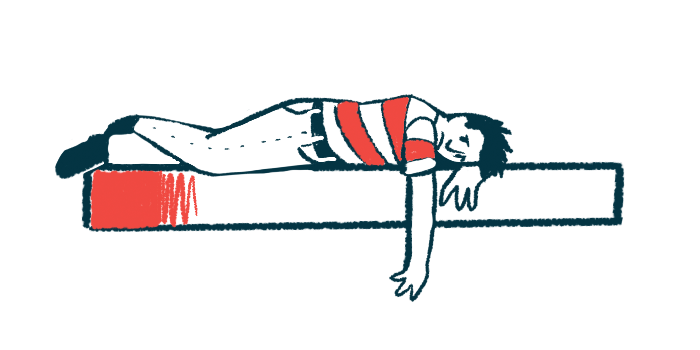Restless legs syndrome is common, affects sleep quality in CF
CF-related diabetes, poor sleep increase risk of restless legs syndrome: Study

Restless legs syndrome (RLS), a disorder characterized by an irresistible urge to move legs or other body parts, especially during sleep, is highly prevalent among adults with cystic fibrosis (CF), a study shows.
A higher percentage of hemoglobin A1c, or HbA1c, indicative of CF-related diabetes (CFRD), and poor sleep quality were found to be independent risk factors for RLS.
“Evaluation and treatment of RLS should be part of the overall management of CF patients,” researchers wrote in the study “Restless legs syndrome is prevalent in adults with cystic fibrosis and impacts sleep quality,” which was published in the Journal of Cystic Fibrosis.
CF is caused by mutations in the CFTR gene, which impair the flow of chloride across the cell membrane. As a result, a thick and sticky mucus builds up in organs such as the lungs and pancreas, making patients more susceptible to infections and lung damage.
While the pro-inflammatory environment of CF may increase the likelihood of RLS, data on the prevalence of this disorder in CF patients, as well as its potential risk factors, remain limited.
Study assesses prevalence, severity of RLS in 75 CF patients
A team led by researchers at the University of Nebraska Medical Center (UNMC) assessed the prevalence and severity of RLS in 75 CF patients (mean age of 34 years, range 20-60 years) followed at the UNMC adult CF center between November 2015 and April 2016. A group of 75 healthy individuals, which could include spouses and friends of the patients, was recruited as a control.
Body mass index, a measure of body fat, was significantly lower in CF patients compared with controls (mean 23.3 vs. 26 kg per square meters).
A questionnaire focused on RLS symptoms, including frequency and severity, was given to all participants. Definite RLS was considered when patients had an urge to move their legs or other body parts while sitting or lying down, their symptoms got worse when sitting or lying down, and their discomfort was more severe in the evening. Significant RLS was when symptoms occurred more than twice weekly, with moderate to severe distress.
Among CF patients, 27 (36%) had definite RLS. Seven of these patients (26%) had significant RLS symptoms, a prevalence of 9% in the total CF group. In contrast, 11 controls (14.7%) had definite RLS, with none reporting significant symptoms.
To confirm these findings, the team recruited a larger group of 191 CF patients from UNMC and the University of Iowa Hospitals & Clinics between 2019 and 2021.
Participants in this larger group were given the same RLS questionnaire, along with the Pittsburgh Sleep Quality Index (PSQI). This validated tool assesses sleep quality in adults over the past month, with global scores of five or higher indicating poor sleep quality.
Evaluation and treatment of RLS should be part of the overall management of CF patients.
Daytime sleepiness experienced by CF patients also evaluated
Daytime sleepiness was also evaluated using the Epworth sleepiness scale, wherein scores of 11 or higher indicate increased daytime drowsiness.
Among this group, 53 participants (27.7 %) had definite RLS, 15 of whom (28%) had significant RLS symptoms — a prevalence of 7.8%, similar to that of the first group.
The researchers next investigated potential risk factors associated with RLS prevalence or severity.
CFRD, specifically the percentage of HbA1c, was linked to the prevalence and severity of RLS. Measured in a blood sample, HbA1c indicates the average sugar levels in the bloodstream over the previous 2-3 months. A 6.5% or higher value is routinely used to diagnose type 2 diabetes in non-CF populations.
CF patients with definite RLS had a mean HbA1c value of 6.6%, whereas those with significant RLS symptoms had a mean 7.2% HbA1c, which was significantly higher than the 6% HbA1c in participants without RLS.
RLS was more likely to occur in those with a family history: 15.8% of patients with definite RLS and 26.7% of participants with significant RLS symptoms had an affected family member, compared with 2.9% of those without RLS. Several participants with CF did not know their family history of RLS.
Medications for mood disorders linked to RLS
The use of medications for mood disorders, such as selective serotonin reuptake inhibitors and serotonin-norepinephrine reuptake inhibitors, were also associated with having RLS, which was particularly noteworthy in those with significant RLS symptoms.
Iron deficiency, previously associated with RLS in the general population, was not deemed a risk factor.
Further analysis showed hospitalizations due to CF exacerbations (periods of acute worsening of symptoms), number of days on antibiotics in the past year, and worse lung function significantly associated with RLS.
While sleep quality was found to be poor for most CF patients, it got worse in the definite RLS group and even more so in those with significant RLS symptoms, as shown by PSQI scores.
PSQI domains most affected included sleep disturbance, dysfunction due to sleepiness, overall sleep quality, and needing medications to sleep. Also, excessive sleepiness was more frequent in the significant RLS group (57.1%) compared to the definite RLS (24.3%) and non-RLS (14.4%) groups.
A subsequent, more complex analysis confirmed that poor sleep and HbA1c percentage were independent risk factors for RLS.
“Future studies are warranted to look at the relationship between blood glucose levels and the pathogenesis [disease processes] of RLS. Also, it is not known which treatment option is most effective for RLS in [people with CF],” the scientists concluded.
As for limitations, the team noted the study did not have enough participants to properly evaluate the link between lung function and CF hospitalizations with RLS.









